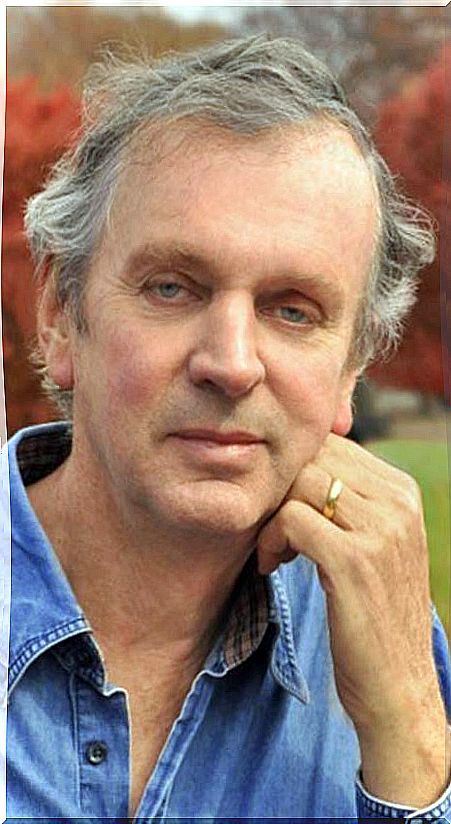“It Is Convenient To Take A Moment Each Day To Thank”
Considered one of the hundred leading thinkers of global thought, scientist and researcher Rupert Sheldrake claims to have abandoned his atheistic beliefs when he saw that the vision of science is enriched and expanded when it takes into account the possibility that there is something beyond us.

Rupert Sheldrake trained as a biologist at the University of Cambridge, where he has also developed part of his work as a researcher. He studied Philosophy and History of Science at Harvard University and, throughout his long career, he has written not only numerous widely cited scientific publications, but also 14 books.
One of its most revolutionary hypotheses is the existence of morphic resonance fields, which suggests that nature has memory and that each system is formed from a single morphic field with a collective or associated memory, and not from immutable laws. universal.
“Each animal, plant or mineral species has a collective memory to which all members of the species contribute and to which they make up,” says Rupert Sheldrake, of whom Editorial Kairós has just published his book Paths to Go Beyond in digital format . Spiritual practices in the age of science where he analyzes how seven daily practices such as practicing a sport, fasting, learning about animals, cannabis and psychedelics, celebrating festivals and holy days, good habits and kindness just as prayer can lead us to spiritual experiences.
Sheldrake argues how these practices can take us beyond normal, familiar, everyday states of consciousness and open us to expanded forms of consciousness.
This work is the continuation of Science and Spiritual Practices , in which this scientist and spiritual explorer already analyzes what happens when we incorporate seven spiritual practices into our lives such as gratitude, meditation, connecting with nature and contemplating beauty. of a landscape, the relationship with plants, singing in a group, performing a ritual (present in many cultures especially when there is a birth or death or a passage from one stage to another in life) or making a pilgrimage.
– Are spirituality and science complementary? Why did you start researching spirituality?
– I am a scientist and I have dedicated my career to research, but I am also interested in spiritual practices. I started to meditate and do yoga in the seventies and found this field more and more interesting, especially after my stay in India where I was living for about seven years. That is why my book Science and Spiritual Practices offers the two sides of my life.
But in addition, science also joins spiritual practices through an increasing number of scientific studies on the effects of meditation, on the effects of connection with nature, the benefits of chanting and mantras and meditation. .
In general, these scientific studies show that spiritual practices make people happier, healthier and longer lived.
– Is it easy to experience a heightened state of consciousness?
– Many people have experiences in which they feel connected to something greater than themselves, with a consciousness greater than their own. In mystical experiences, which can occur spontaneously, even during childhood, people feel a presence, a greater and more inclusive awareness, or a sense of deep connection.
Sometimes these experiences occur in emergency situations, such as near death experiences.
Other times they take place in a natural environment. Sometimes they also happen when we are in love. But spiritual practices are a means of increasing the likelihood of experiencing a state of awakening and of being open to making them possible.
–Of the spiritual practices that you have analyzed, which of them do you practice regularly?
–All the spiritual practices that I talk about in my books Science and Spiritual Practices and Ways to Go Beyond are practices that I do myself. Each book analyzes seven different spiritual practices out of a total of 14, although there are many more that I do not talk about, such as yoga, tai chi, or the spiritual dimension that the arts have.
These practices are not mutually exclusive and all traditional religions and shamanic cultures have combined some of them, such as the combination of singing all together, fasting, starting a pilgrimage, maintaining a special relationship with animals or participating in rituals.
That is why I do not feel the need to choose between one of them or to stay with only one. Having different spiritual practices allows them to complement each other and, of course, some of these practices are better suited to some people than others and also work better at one stage of life than another.
For example, the joy of participating in a team sport is more likely to work for young people, while a quieter and more contemplative practice will be suitable for older people.
– From a materialistic or agnostic vision can a meaning be found in life?
– Most of these spiritual practices do not presuppose a religious faith. For example, it is possible to meditate without believing in a form of consciousness greater than that of the human being and, in fact, now there are many atheists and agnostics who meditate. But some of these practices only make sense if there are forms of consciousness beyond the human level.
This is the case, for example, of prayers in which we ask and that involve invoking a higher spiritual being at the beginning of the prayer, such as when we pray an Our Father or the Hail Mary. Prayers involve believing in a higher form of consciousness beyond the human, however meditation does not necessarily depend on such belief.
Atheists and agnostics also participate in spiritual practices that were traditionally part of religious life, such as pilgrimage. In fact, not all of the hundreds of thousands of people who make the Camino de Santiago are devout Catholics.
Here in Britain, The British Pilgrimage Trust organizes pilgrimage groups to walk to ancient holy sites using the slogan ‘bring your own beliefs’. These practices are not so related to beliefs, but above all to the experience they report to the person.
The effect of spiritual practices is to make people feel more connected and united, and this generally makes people feel happier and their lives take on greater meaning.
– Does the current boom in the practice of meditation respond to a need for spirituality in our modern, liquid and consumerist cultures?
– I believe that the significant increase in the number of people who practice meditation is a consequence of the extreme secularization of all sectors of our lives and of how we have dissociated ourselves from all traditional religious practices and, therefore, from the experiences that these entailed. for the people.
One hundred years ago, most of the people in Europe followed their ancestral religion, predominantly the Christian religion, but also Judaism and other minority religions. Instead today many people, especially the younger ones, have completely uprooted themselves from these traditions because they have converted to the materialistic or atheistic worldview.
But this also leaves them with unmet needs. And meditation is one of the most accessible practices in the modern world and also has great benefits for health and well-being.
–Of the many scientific studies that have been carried out on the effects of meditation, which one did you find the most surprising?
–Meditators are literally the target of scientific researchers! To study the effects on the brain, it is required that the subject be connected to a device that allows brain exploration or that this person is still while brain activity is measured.
One of the effects of meditation is to lead to a reduction in the activity of the so-called Default Mode Network (DMN) of the brain (a brain network that includes different interacting brain regions and that, according to neuroscience, have a highly correlated activity between Yes).
The interconnected regions of the brain associated with self-talk, rumination, worry, and anxiety lower their activity.
However, I don’t think this is surprising because already many people during meditation have been able to experience this decrease in self-talk on their own skin.
These brain studies simply confirm what people already know. The most surprising finding for me is that the long-term practice of meditation, as in the case of Tibetan monks, can lead to anatomical changes in the brain.
– Do you think there is an anatomical part of the brain linked to spirituality?
– The materialistic philosophy affirms that the mind is nothing more than the result of brain activity. But this is a simple assumption and leads to serious philosophical problems. In fact the very existence of human consciousness is called “the hard problem” in the philosophy of mind. If our brains are nothing more than physico-chemical computers, they cannot be self-conscious at all.
Many people, including myself, view the brain as a tuner or radio receiver that filters signals and not as an organ capable of producing consciousness on its own.
Our consciousness works through our brain, but is not produced by it. This vision leaves open the possibility of connecting with forms of consciousness beyond our own and approaches traditional visions of the spiritual realm.
How does the practice of gratitude help us?
-Thank you is to recognize the current and the flow of which we are part. We receive many things thanks to other people and thanks to nature. Our life itself is a gift as is the Earth and the solar system. We have neither done it nor earned it.
The culture we have inherited is another gift as is our language. I inherited English, the language in which I think and develop my social being, just as you inherited Spanish. If we take these things for granted and don’t appreciate them, then we don’t see them as gifts that are part of a flow greater than ourselves.
At a simpler level, the practice of gratitude is a matter of good manners and that is why most parents teach their children to give thanks when they receive a gift. The opposite of gratitude is the feeling of being entitled or taking things for granted.
However, different positive psychology studies have shown that grateful people are happier and, therefore, thanking is one of the simplest and most fundamental spiritual practices. In my book I suggest two ways to do it.
-Which are?
–One of them is to say thank you before each meal, as families used to do before and, if people are not comfortable with this, then simply hold hands in a circle around the table in silence to create a short pause in which all diners can give thanks in their own way. It is the method I found for practicing gratitude in my family.
Second, take a moment each day to remember the blessings we have received and the things we are grateful for. It is an extremely simple way to practice gratitude and offers a great sense of connection and well-being.
–Our education does not help us to connect with spirituality. What do you think about that?
-Modern educational systems tend to be completely secular and in some countries they are explicitly atheistic, as is the case of the Soviet Union and modern China. Even when they are not explicitly atheist, these educational systems often just completely ignore the spiritual dimension.
In multicultural societies it would be difficult for state schools to propagate a single religion, but it should be possible for schools to teach some spiritual practices that may be common to all religions such as the practice of connecting with nature, appreciating beauty, giving thanks. , sing together …
Some schools are already starting to do so and I hope this approach will spread. It would be helpful for students to go on pilgrimages together, especially at those key stages in their educational career such as before leaving school or at the beginning of the school year.
–How does nature help us to connect with something greater than ourselves?
– The materialistic vision of nature takes it for granted and within scientific institutions nature is considered as something inanimate, without consciousness or purpose, which generates a distancing from it.
However, the romantic tradition has always emphasized the connection with nature, a connection that many people feel directly. And the more open we are to experiencing the beauty of flowers, to appreciating the graceful movements of animals, the beauty of landscapes, the sky at night, the sounds of birds singing and so on, the more we feel that we are in Contact with a world beyond the human and this sense of connection generally makes people happier and leads people beyond their own limited concerns.
–Many traditions include rituals. How do rituals help us through especially difficult times in our lives?
–Rituals and rites of passage such as baptisms, weddings and funerals place the life of an individual within a much broader social context and this not only through the participation at the same time of other people in these acts but also because it connects them with what they have felt when they in turn participated in these same rites before.
My hypothesis of morphic resonance suggests that when similar activity patterns occur they resonate with similar activity patterns that are earlier. There is a connection through time. So rituals not only connect us with others in this present moment, but also with our ancestors and those who have done the same rituals before us.
This awakens a feeling of groundedness with something deeper and places our life within a much larger context than ourselves and our merely individualistic concerns.
– Could you explain what morphic resonances are?
– The theory of morphic resonance fields underlies the idea that there is a kind of memory that is inherent in nature.
The laws of nature are more like habits and each species has a kind of collective memory to which each individual connects and contributes to enrich. Within the human it would be like Jung’s idea of the collective unconscious.
–He asserts that spirituality can be found in very daily activities…
–There are many daily activities that can include a spiritual dimension such as caring for plants, singing, dancing or playing sports or also when we appreciate the way animals live in the present.
For many people meditation and prayer are daily practices as well as giving thanks for the food received. Most spiritual practices are free!
And unlike consumerism that requires money and damages the earth due to its increasing demand for raw materials and energy consumption, most spiritual practices are very environmentally friendly!









